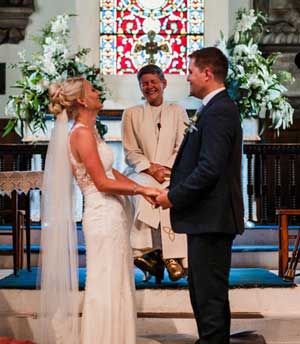Ways to ensure disabled people are not alienated from church life
 Revd Katie Tupling, part-time Disability Adviser for Oxford Diocese (Church of England) and co-founder of Disability and Jesus, invites us to consider how we can adjust our current practices to become more inclusive.
Revd Katie Tupling, part-time Disability Adviser for Oxford Diocese (Church of England) and co-founder of Disability and Jesus, invites us to consider how we can adjust our current practices to become more inclusive.
As an Anglican priest who uses crutches (and sometimes a wheelchair), I often get drawn into conversations about the ‘right’ words and phrases to use when leading a service, the difficulties around posture and accessibility when planning more creative worship spaces. Disabled people can be alienated from church life by liturgy, language, posture and expectations. Let’s have a brief look at some examples, and notice how we can adjust our current practices to become more inclusive.
Language and liturgy
‘We pray for those in power who are blind to poverty, and deaf to the cries of the poor…’
It can be hurtful when our disabilities are used as analogy for sin. Blind people are not oblivious to poverty, nor are deaf people unaware of those who are poor. Often, people wilfully ignore poverty. Disability is often associated with loss, whereas physical ability is associated with faithfulness and virtue. Consider the line from the hymn ‘Amazing Grace’: ‘was blind but now I see’. The late John Hull offered the alternative ‘was bound but now I’m free’. Could you change this when you sing it in church?
‘Lord in your mercy, hear our prayer.’
For many people who are non-verbal, this response is problematic. Are their prayers ‘heard’ by God? How about people whose first and only language is British Sign Language (BSL). Their prayers cannot be ‘heard’ in the way which the liturgical response assumes. Many deaf churches use the response ‘Lord in your mercy, receive our prayer’. The word ‘receive’ includes prayers which are spoken aloud and whispered almost silently, unspoken, and signed in BSL. Could you adapt your prayers and intercessions to use this alternative response?
Movement and posture
‘We stand to sing our hymn’, or the latest alternative, ‘please stand if you are able’
There is a long tradition that we stand to sing, sit to listen (to readings and sermons) and kneel to pray. Many disabled people find themselves having to put in the filter which says, ‘I know I don’t have to, and it’s an implied invitation, but…’. To remain seated during a hymn is to risk stares and tuts. If the lyrics are projected onto a screen, it is likely that you won’t be able to see them without standing up. For anyone who struggles to stand, or combine standing with singing, this expectation is difficult. I begin services by saying ‘I might invite you to stand, sit or kneel, at various points in the service. These are invitations, not commands! Please adopt any position which helps you to join in.’
‘Come to the front’ or ‘Go to one of the activity/prayer stations’
If you are in a space with flexible seating, you might experiment with more creative layouts and activities. All-age worship often includes craft and activities at tables, an invitation to talk to your neighbour or in small groups. It is important to factor in ‘traffic flow’. Have you made provision for a wheelchair user to be able to get to and have space at the tables? Are the activities all noisy/messy ones and is there a quieter area for anyone who might be overwhelmed by the environment? Is everyone welcome to each physical space and fully included in the activities?
 Expectations
Expectations
‘Preachers always use the pulpit, or the lectern.’
It can be daunting to be faced with stairs up to a pulpit, or a large lectern on a plinth, if you use some form of mobility aid, and impossible if you are a wheelchair user. I have learned over the years that I am at my best (leading, preaching or presiding) when I am sat down. I politely but firmly say ‘no, thank you’ when invited to use the pulpit or lectern. I bring my own tall stool to sit behind the altar when I preside at Communion (much to some people’s discomfort). Modelling this gives permission to people who may find themselves struggling with the inherited way of doing things.
I also ask congregations to sit down during the Eucharistic Prayer, or the words of the Baptism, so that everyone can see what is happening.
What do you notice in your place of worship? What adjustments could you make?
More teaching resources can be found on my YouTube channel.
Want to learn more?
Not a Roots subscriber?
